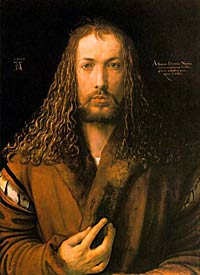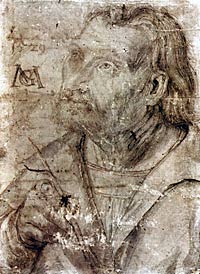Readings:
Psalm 96:7-13
Exodus 35:21-29
Romans 8:1-11
John 19:31-37Preface of God the Son
[Common of an Artist, Writer, or Composer]
[For Artists and Writers]
PRAYER (traditional language)
We give thee thanks, O Lord, for the vision and skill of Albrecht Dürer, Matthias Grünewald and Lucas Cranach the Elder, whose artistic depictions helped the peoples of their age understand the full suffering and glory of thine incarnate Son; and we pray that their work may strengthen our faith in Jesus Christ and the mystery of the Holy Trinity; who livest and reignest, one God, for ever and ever. Amen.
PRAYER (contemporary language)
We give thanks to you, O Lord, for the vision and skill of Albrecht Dürer, Matthias Grünewald and Lucas Cranach the Elder, whose artistic depictions helped the peoples of their age understand the full suffering and glory of your incarnate Son; and we pray that their work may strengthen our faith in Jesus Christ and the mystery of the Holy Trinity; for you live and reign, one God, for ever and ever. Amen.
This commemoration appears in A Great Cloud of Witnesses.
Return to Lectionary Home Page
Webmaster: Charles Wohlers
Last updated: 6 June 2020
ALBRECHT DÜRER, 1528
MATTHIAS GRÜNEWALD, 1529
LUCAS CRANACH the ELDER, 1553
ARTISTS, 5 August
 Albrecht
Dürer (May 21, 1471 – April 6, 1528) was a German
painter, printmaker and theorist from Nuremberg. His prints established
his reputation across Europe when he was still in his twenties, and he
has been conventionally regarded as the greatest artist of the Renaissance
in Northern Europe ever since. His well-known works include the Apocalypse
woodcuts, Knight,
Death, and the Devil (1513), Saint
Jerome in his Study (1514) and Melencolia
I (1514), which has been the subject of extensive analysis and
interpretation. His watercolors mark him as one of the first European
landscape artists, while his ambitious woodcuts revolutionized the potential
of that medium. Dürer's introduction of classical motifs into Northern
art, through his knowledge of Italian artists and German humanists, have
secured his reputation as one of the most important figures of the Northern
Renaissance. This is reinforced by his theoretical treatise which involve
principles of mathematics, perspective and ideal proportions. (More
at Wikipedia)
Albrecht
Dürer (May 21, 1471 – April 6, 1528) was a German
painter, printmaker and theorist from Nuremberg. His prints established
his reputation across Europe when he was still in his twenties, and he
has been conventionally regarded as the greatest artist of the Renaissance
in Northern Europe ever since. His well-known works include the Apocalypse
woodcuts, Knight,
Death, and the Devil (1513), Saint
Jerome in his Study (1514) and Melencolia
I (1514), which has been the subject of extensive analysis and
interpretation. His watercolors mark him as one of the first European
landscape artists, while his ambitious woodcuts revolutionized the potential
of that medium. Dürer's introduction of classical motifs into Northern
art, through his knowledge of Italian artists and German humanists, have
secured his reputation as one of the most important figures of the Northern
Renaissance. This is reinforced by his theoretical treatise which involve
principles of mathematics, perspective and ideal proportions. (More
at Wikipedia)
 Matthias Grünewald, (c. 1470 – August 31, 1528), was an important German Renaissance painter of religious works, who ignored Renaissance classicism to continue the expressive and intense style of late medieval Central European art into the 16th century.
Matthias Grünewald, (c. 1470 – August 31, 1528), was an important German Renaissance painter of religious works, who ignored Renaissance classicism to continue the expressive and intense style of late medieval Central European art into the 16th century.
Only ten paintings—several consisting of many panels—and thirty-five drawings survive, all religious, although many others were lost at sea in the Baltic on their way to Sweden as war booty. His reputation was obscured until the late nineteenth century, and many of his paintings were attributed to Albrecht Dürer, who is now seen as his stylistic antithesis. His largest and most famous work is the Isenheim Altarpiece in Colmar, Alsace. (More at Wikipedia)
Lucas Cranach the Elder, 4 October 1472 – 16 October 1553) was a German Renaissance painter and printmaker in woodcut and engraving. He was court painter to the Electors of Saxony for most of his career, and is best known for his portraits, both of German princes and those of the leaders of the Protestant Reformation, whose cause he embraced with enthusiasm, becoming a close friend of Martin Luther. He also painted religious subjects, first in the Catholic tradition, and later trying to find new ways of conveying Lutheran religious concerns in art. He continued throughout his career to paint nude subjects drawn from mythology and religion. He had a large workshop and many works exist in different versions; his son Lucas Cranach the Younger, and others, continued to produce versions of his father's works for decades after his death. (More at Wikipedia)